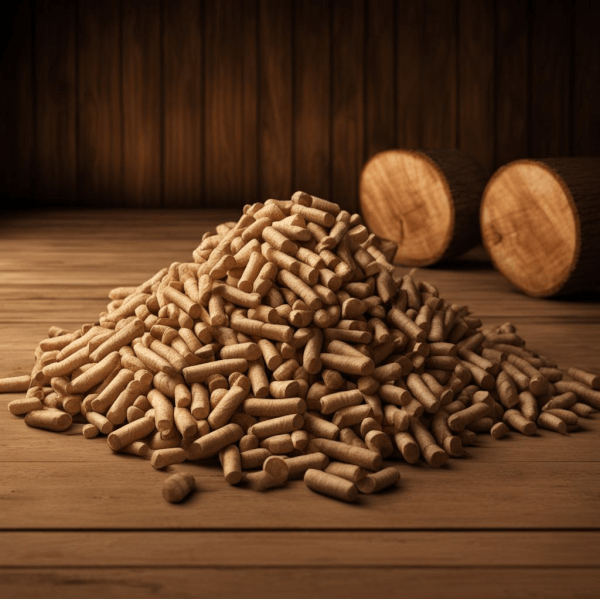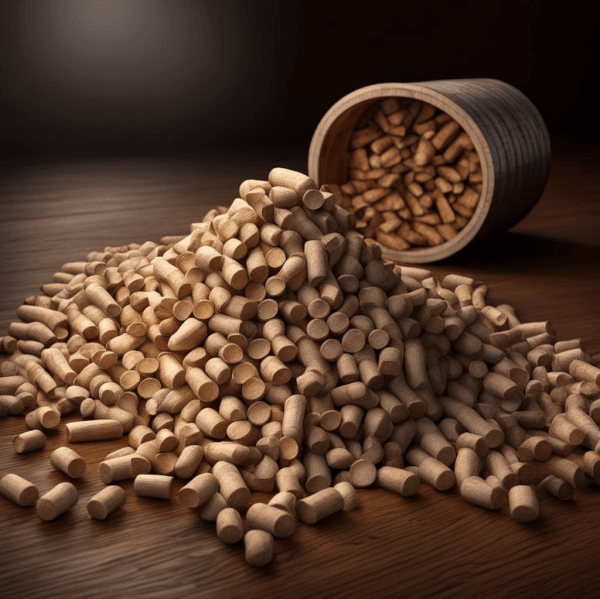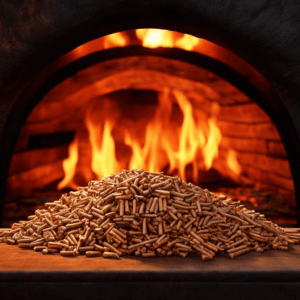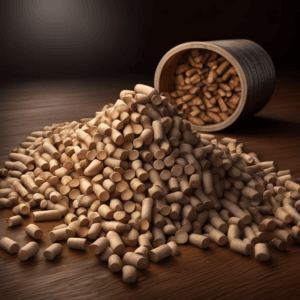Have you ever been ready to fire up your pizza oven, only to find that your wood pellets have gone bad? It’s frustrating, isn’t it? You’re all set to make your favorite wood-fired pizzas, but instead, you’re stuck with pellets that won’t light or give off enough heat.
In this article, I’ll share the solutions to this common problem. By storing your wood pellets properly and keeping an eye out for signs of deterioration, you can ensure that they remain in prime condition for all your pizza-making adventures. Let me show you how.
Do Wood Pellets Go Bad?
They can go bad if we’re not careful.
But with some proper care and knowledge, we can keep those wood pellets in top shape for our pizza-making adventures.
Store them in an airtight container in a cool, dry place away from UV rays. Plus, check the temperature and humidity levels regularly with a thermometer that has a humidity gauge.
Proper Storage is Key
It’s very important to find a suitable storage spot for your wood pellets.
Keep them in a cool, dry place, away from any moisture, humidity, or direct sunlight.
I prefer using airtight containers or sealed bags to ensure they stay fresh for longer periods.
Moisture Matters
Now, about moisture levels. It’s important to strike the right balance – not too wet, not too dry.
Ideally, we’re looking for a moisture content of around 10% or less for optimal burning.
If the pellets start feeling damp, it’s time to take action.
Wet pellets can cause issues and affect the quality of our pizzas.
Shelf Life
Like any ingredient, wood pellets have an expiration date.
Typically, they’ll remain usable for about 1-6 months, depending on storage conditions and the humidity in your area.
Always keep track of the expiration dates and rotate your stock accordingly.
This will help you use them at their best.
Pellet Quality Matters
Not all pellets are created equal.
Quality is key here.
Look for pellets that are tightly compressed with minimal dust.
These tend to hold up better over time and provide a more consistent burn.
Investing in high-quality pellets can make a big difference in the performance of your pizza oven.
I prefer Lumberjack pellets for my Ooni.
Here is a review of the top 5 alternatives to Ooni brand pellets.
So, do wood pellets go bad? Yes, they can.
But by storing them properly, controlling moisture levels, and choosing high-quality pellets, you can prolong their lifespan and keep your pizza oven ready for action whenever you need it.
Wood pellets overview

Wood pellets for pizza ovens are small, cylindrical pieces of compressed wood.
They’re made from sawdust or other leftover wood materials.
These pellets are purpose-built to be the primary fuel for pizza ovens, grills, smokers, and similar appliances.
To make them, manufacturers compress wood fibers tightly under high pressure.
Good manufacturers usually don’t add any extra stuff like binders or additives.
This compression process results in dense, uniform pellets that burn efficiently and cleanly.
When you load them into a pizza oven, these pellets catch fire easily and produce a steady flame.
As they burn, they give off heat.
And these are the perfect conditions for cooking pizzas at those high temperatures we love.
Their consistent size and shape produce an even burn, maintaining a stable heat output throughout the cooking process.
In essence, wood pellets for pizza ovens offer a straightforward and effective way to fuel your pizza-making process.
They’re all about convenience and enhancing the authentic wood-fired flavor of your pizzas.
Factors that can make wood pellets go bad

Let’s break down the things that can affect how long your wood pellets stay good for your pizza oven:
1. Humidity:
Moisture is a big deal.
Wood pellets soak it up from the air, which can make them swell and tough to burn efficiently.
To keep them in top shape, store them where it’s dry.
Aim for a moisture content of less than 10% in your pellets.
Too much moisture can make them hard to light and keep burning steadily.
2. Exposure to Sunlight:
Sunlight can be rough on wood pellets.
The UV rays break down the outer layers, making them more prone to soaking up moisture.
Try to store your pellets in a shady spot or cover them up to protect them.
3. Storage Conditions and Temperature:
Consistency is key here.
Fluctuating temperatures can cause pellets to expand and contract, which can wear them down over time.
Keep your pellets in a stable, cool, and dry place, away from extreme heat or cold.
4. Pest Infestation:
Bugs and rodents love to get into stored pellets.
They bring moisture and dirt, making the pellets unsuitable for cooking.
Keep an eye out for any signs of pests and use sealed containers to keep them out.
5. Quality of the Pellets:
Not all pellets are made equal.
Higher quality ones are tightly packed.
This makes them sturdier and longer-lasting.
They also produce less dust, which can clog up your oven and cause uneven burning.
6. Ventilation:
Good airflow is essential for keeping your pellets in good condition.
It helps prevent moisture buildup and lets any extra gases escape, reducing the risk of fires.
7. Sealed Packaging:
Pellets that come in resealable packages, like OOFT, tend to last longer than those stored in open containers.
Sealed packaging keeps out moisture, dust, and other stuff that can mess with your pellets.
Signs that wood pellets have gone bad
1. Discoloration:
If you notice your wood pellets looking darker or having a grayish tint, it’s a sign something’s off.
This discoloration usually happens when pellets absorb moisture or get exposed to the elements, which can affect how well they burn.
2. Mold or Mildew Growth:
Finding mold or mildew on your pellets is a surefire sign of trouble.
It means they’ve gotten too damp, likely from being stored in a humid environment.
Using moldy pellets is a no-go, as burning them can release harmful spores.
3. Unpleasant Odor:
Good wood pellets should smell clean and natural.
If they start giving off a musty or foul odor, it’s a red flag.
This could mean mold, decomposition, or contamination, which can ruin the taste of your pizzas and might even be harmful to your health.
4. Breakage or Crumbling:
Healthy pellets should stay intact, but if they start falling apart easily, it’s a bad sign.
This usually happens when they’ve absorbed too much moisture or if they’re low-quality.
Crumbly pellets can cause problems in your oven and lead to uneven cooking.
5. Difficulty Igniting:
If your pellets won’t light or struggle to stay lit, something’s not right.
It could be because they’re too wet, poor quality, or contaminated.
Either way, it means they’re not going to burn efficiently, which will affect your pizza-making process.
6. Insufficient Heat Output:
Not getting enough heat from your pellets?
That’s a problem.
It could mean wood pellets for a pizza oven have gone bad and aren’t burning properly.
This can leave your pizzas undercooked or with unevenly cooked toppings, which is not what we want.
7. Excessive Ash Production:
While some ash is normal, too much can be a sign of trouble.
If your pellets are producing more ash than usual, it could mean they’re impure or low-quality.
Excessive ash can also cause clogs in your oven and make it less efficient.
By keeping an eye out for these signs and checking your pellets regularly, you can make sure they’re still good to use in your pizza oven.
If you spot any of these warning signs, it’s best to replace your pellets with fresh ones to avoid any issues with your pizza-making process.
How to properly store wood pellets for pizza oven

1. Choosing the Right Storage Container:
Opt for containers that are airtight and moisture-resistant to keep your wood pellets in optimal condition.
Sealed plastic bins or heavy-duty plastic bags with a secure seal are ideal choices.
Avoid using containers that allow air or moisture to seep in, as this can lead to degradation of the pellets.
2. Keeping Pellets in a Dry and Cool Location:
Find a dry and cool spot for storing your wood pellets.
Moisture is the enemy here.
So avoid areas with high humidity or moisture levels, such as basements or outdoor sheds.
Instead, choose a garage or storage room where the temperature remains relatively stable and humidity is low.
3. Avoiding Exposure to Sunlight:
Sunlight can degrade the quality of wood pellets over time.
So it’s important to keep them away from direct sunlight.
Store your pellets in a shaded area or cover them with a tarp or cloth to shield them from UV radiation.
This helps preserve their integrity and prolong their lifespan.
4. Regularly Checking and Maintaining Pellets:
Make it a habit to inspect your wood pellets regularly for any signs of moisture, mold, or degradation.
If you notice any discoloration, mold growth, or unusual odors, it’s best to discard those pellets and replace them with fresh ones.
In addition to that, keep the storage area clean and free from debris to prevent contamination of the pellets.
5. Monitoring Temperature and Humidity Levels:
Keep an eye on the temperature and humidity levels in the storage area.
This will help you to ensure optimal conditions for your wood pellets.
Use a thermometer and hygrometer to monitor these factors and make adjustments as needed.
If the humidity level rises above recommended levels, consider using a dehumidifier to maintain a dry environment.
6. Rotating Stock:
To prevent pellets from sitting too long and potentially degrading, practice rotating your stock regularly.
Use older pellets first and replenish your supply with fresh ones to have a consistent supply of high-quality fuel for your pizza oven.
7. Securing the Storage Area:
Make sure that the storage area is secure and inaccessible to pests and rodents.
Use pest-proof containers and seal any entry points to prevent infestations that can compromise the quality of your wood pellets.
How can I tell if my wood pellets are in good condition?
Look for signs like uniform color, dry texture, and a clean, natural smell.
Healthy pellets should be intact and free from mold, mildew, or discoloration.
What’s the best condition for wood pellets?
The best condition for wood pellets is dry and cool, with low humidity levels.
They should be stored in airtight containers or sealed bags to protect them from moisture and environmental factors.
Can I test wood pellets at home to see if they’re still good?
Yes, look for signs of moisture, mold, or degradation, and try igniting a few pellets to see if they light easily and produce a steady flame.
You can also put a few pieces in a bowl of water. Good-quality pellets will sink and those that have gone bad will float.
If you have any doubts about the quality of your pellets, it’s best to replace them with fresh ones.
Can I store wood pellets outside?
I don’t recommend this unless you have a weatherproof storage spot.
Exposure to rain, snow, and fluctuating temperatures can make wood pellets go bad and shorten their lifespan.
If you must store pellets outside, use a waterproof container or cover them with a tarp to protect them from the elements.
How long do wood pellets typically last in storage?
The lifespan of wood pellets in storage can vary depending on factors like storage conditions, pellet quality, and environmental factors.
In general, wood pellets can last anywhere from 1 to 6 months under good conditions in an airtight container.
Can I store wood pellets in my basement or garage?
While basements and garages can be convenient storage locations, they may not always provide the ideal conditions for wood pellets.
Basements can be prone to high humidity.
And garages can experience temperature fluctuations.
If you decide to store pellets in these areas,
keep them in sealed containers and monitor the temperature and humidity levels regularly.
How should I dispose of old or unusable wood pellets?
You can dispose of them by spreading pellets on your garden as mulch or compost.
Alternatively, you can burn them in a safe outdoor area.
Or dispose of them following local waste disposal regulations.
Avoid burning moldy or contaminated pellets indoors. This can release harmful pollutants into the air.
Can I store wood pellets in the bag they came in?
Most bags may not provide enough protection against moisture and environmental factors, that can make pellets go bad.
So they aren’t useful enough for long-term storage.
Put your pellets in airtight containers or sealed bags.
This can help prolong their lifespan and maintain their quality.
What should I do if I notice mold on my wood pellets?
Don’t use them. Just throw these pellets away and replace them with fresh ones.
Burning moldy pellets can release harmful spores into the air, posing health risks.
And don’t use them in your garden either.
Can I mix old and new wood pellets?
It’s generally fine as long as the old pellets are still in good condition.
However, if the old pellets show signs of degradation or contamination, get rid of them to avoid ruining your new pellets.
Mixing pellets of different qualities may also result in uneven burning and inconsistent heat output.
Is it okay to vacuum seal wood pellets for long-term storage?
Yes, this can help create an airtight seal that keeps moisture and air away.
However, make sure that the pellets are completely dry before vacuum-sealing them.
This is because any residual moisture can lead to mold growth or make your sealed pellets go bad over time.
Final thoughts
So, the answer is yes, wood pellets for pizza ovens can go bad if not stored properly.
However, with proper storage and care, they can last for more than a year, making them a great option for your pizza-making needs.
Just remember to keep them in a dry, cool place and they’ll be ready to use whenever you’re in the mood for a delicious homemade pizza.










